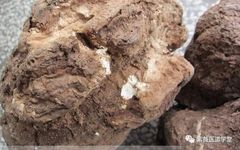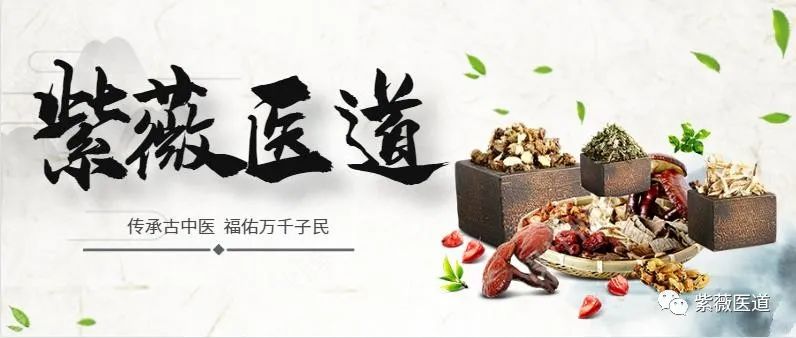
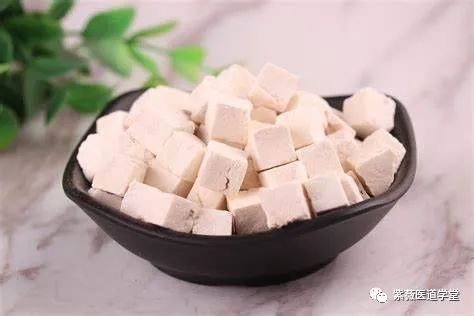
1
Fu Ling (Poria) has five main uses: to stop diarrhea, promote urination, open the pores, eliminate internal heat, and generate body fluids.
2
Qi moves and moistens, while water moves with Qi. When water stagnates, Qi is obstructed, and when Qi is obstructed, water accumulates. Fu Ling primarily acts through Qi, thus its treatment focuses on water. This is clearly illustrated in Zhang Zhongjing’s writings.
For example, when Qi is obstructed, it can promote water (Fu Ling and Gan Cao Decoction); when water is stagnant, it can transform Qi (Wu Ling San); when Qi is reversed by water, it can guide water downwards (Fu Ling, Gui Zhi, Gan Cao, and Da Zao Decoction, Fu Ling, Gui Zhi, Bai Zhu, and Gan Cao Decoction);
when water surges with Qi, it should first be directed downwards, with water guiding as an assistant (Gui Zhi, Wu Wei Zi, Gan Cao, and various modifications); when both water and Qi are obstructed above, it can be released from the side without harm (Fu Ling, Xing Ren, Gan Cao Decoction, Fu Ling, Rong Yan Decoction, Fu Ling, Ze Xie Decoction); when Qi is exhausted externally, it can prevent the loss of Yang from within (Fang Ji Fu Ling Decoction);
when Qi is consumed externally, water is forced internally, thus it is the monarch in the Yang-replenishing formula (Fu Ling Si Ni Decoction); when Qi is obstructed downwards, water stagnates, thus it is effective in pregnancy-related conditions (Gui Zhi Fu Ling Wan, Kui Zi Fu Ling San).
All of these arise from Yin following Yang, dispersing Yang to transform Yin, allowing the turbid to either descend or be expelled externally.The purpose of Fu Ling is to tonify rather than to drain; its use is in draining rather than tonifying.
3
Fu Ling, being mild, can open the orifices, sweet to assist Yang, is a sacred herb for eliminating dampness. Its sweet and neutral flavor tonifies Yang, benefits the spleen, and expels water.
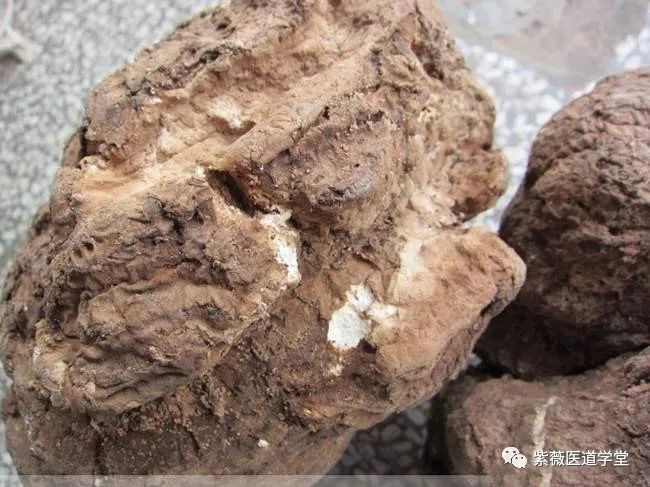
4
Fu Ling can assist various Yin herbs, removing their stagnation; it can also serve as a messenger for various Yang herbs, promoting their flow.It tonifies without causing stagnation, drains without being harsh, and is a pure product that cannot be surpassed.
5
The “Shen Nong Ben Cao Jing” states that Fu Ling is effective for chest and flank Qi reversal, anxiety, fright, and palpitations, which is clinically reliable.
Heavy use of Fu Ling (or Fu Shen) has excellent effects in calming the spirit and soothing emotions.
The condition of “Ben Tun” is a disease of emotional distress; ancient practitioners often used Fu Ling for this condition, not merely for its diuretic properties, but rather for its nourishing and calming effects.
6
In Zhang Zhongjing’s formulas, Fu Ling is indicated for palpitations (palpitations below the heart, palpitations below the navel) and muscle twitching, and it also treats urinary difficulties, dizziness, and irritability, as dizziness and irritability are also types of palpitations.
For urinary difficulties accompanied by palpitations, Fu Ling is effective; however, if there are no palpitations, its efficacy is not observed.
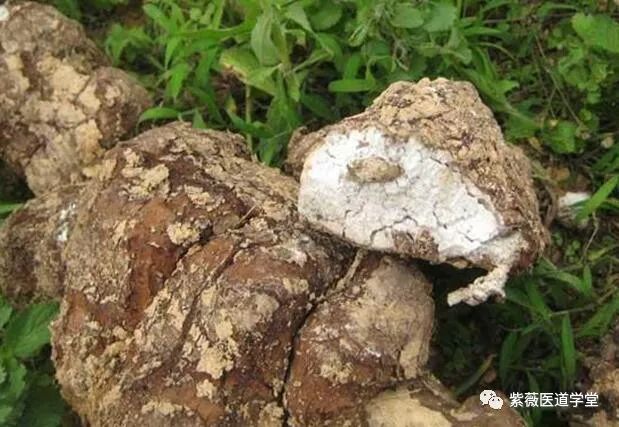
7
Fu Ling combined with Bai Ju Hua, or with Gui Xin, or with Bai Zhu, can be taken in pill or powder form, and can be used regularly for exceptional tonifying effects.
8
Fu Ling combined with Bai Zhu tonifies the spleen, with Che Qian Zi promotes urination, with Ze Xie drains dampness, and when combined with Ban Xia, it achieves the function of drying dampness.
Moreover, Fu Ling combined with Ren Shen, opens the Yang of the stomach; with Bai Zhu, it expels spleen water; with Ai Ye, it stops heart sweating; with Ban Xia, it treats phlegm and fluid retention; with Mu Xiang, it treats persistent diarrhea; with Jun Chuan Lian and Tian Hua Fen, it treats excessive upper and deficient lower thirst; and with Zhu Sha, it calms the heart and alleviates fright.
9
Fu Ling combined with Fu Zi and Shao Yao treats kidney Yang deficiency and body joint pain.
Additionally, Fu Ling can guide herbs downwards, and is commonly used in the method of Fu Ling, Gui Zhi, Bai Zhu, and Gan Cao Decoction to treat severe gastric prolapse, with gurgling sounds in the intestines, and abdominal distension, sometimes accompanied by belching and constipation.Heavy use of Fu Ling, combined with Gui Zhi and Chuan Jiao, often yields results.
Wang Haogu once used Si Ni Decoction with added Fu Ling to treat Yin cold urinary difficulties,stating, “Fu Ling does not promote urination, but rather guides heat herbs downwards, not entering other channels, thus achieving rapid effects,” which reveals the subtleties of using Fu Ling in Si Ni Decoction.
10
Daily use of 15 grams of Fu Ling, 9 grams each of Ze Xie and Shan Yao, decocted in water and taken warm, without adding sugar, for 2-4 months can lower blood sugar.
11
Fu Ling can treat lower limb edema caused by metabolic dysfunction and nutritional deficiencies.
This condition is often seen in women after their reproductive years, accompanied by menstrual irregularities.Fu Ling should be used in large doses, often combined with Dang Shen, Bai Zhu, and Huai Shan Yao.
Anemic edema is also commonly seen in multiparous women,and Fu Ling can be combined with Dang Gui, He Shou Wu, E Jiao, and Ji Xue Teng.
12
For treating alopecia areata, a decoction of Fu Ling can be used: 500-1000 grams of Fu Ling, ground into a fine powder, taken at 6 grams per dose, mixed with boiling water, twice daily.It should be taken continuously until hair roots regrow.
The formation of this condition is often due to water Qi rising to the top, eroding the hair roots, causing them to rot and fall out. This herb can ascend and drain dampness, guiding fluids downwards, thus removing the dampness.
13
For menstrual irregularities due to insufficient Chong and Ren,symptoms include pale yellow complexion, dizziness, small stature, lower back and knee soreness, thin white tongue coating, and thin wiry pulse, often seen in unmarried women.
Treatment should focus on the liver, spleen, and kidneys, primarily using Shan Yao and Fu Ling to tonify both spleen and kidney, which generally yields results.Do not use large doses of blood-moving herbs that deplete Zheng Qi.
Experience formula: 30 grams of Shan Yao, 15 grams of Fu Ling, 10 grams of Dang Gui, and 12 grams of Xu Duan. Those with menstrual irregularities due to cold congealing and blood stasis should not use this.
14
A large, scalloped tongue with teeth marks, palpitations, dizziness, and urinary difficulties are major indications for using Fu Ling.
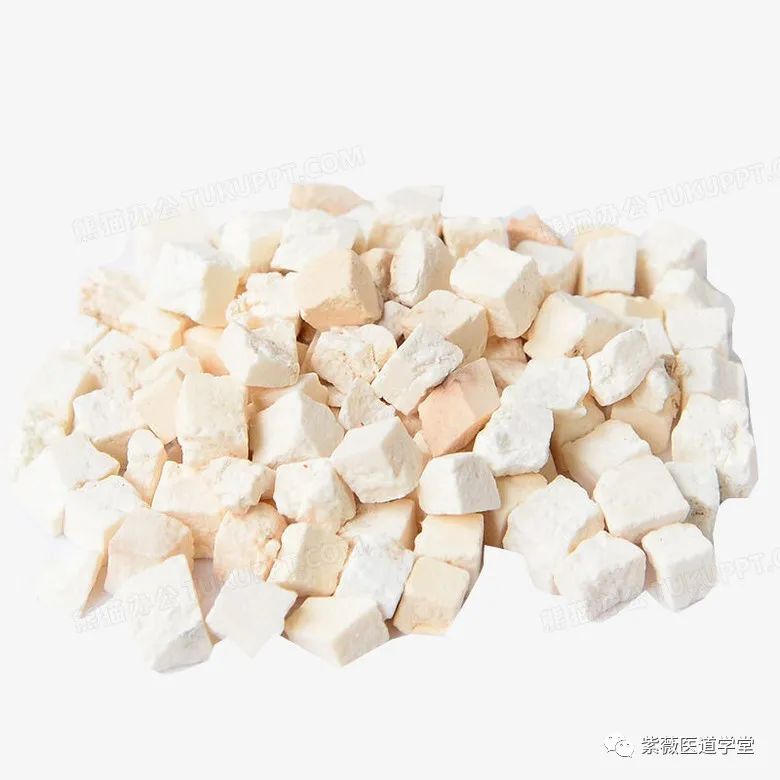
15
When using Fu Ling for calming the spirit, the dosage should be large, typically 30-100 grams; for promoting urination and draining dampness, the dosage should be moderate, generally 15-30 grams; for tonifying the spleen and benefiting the middle, the dosage should be small, ideally 6-12 grams.
Large doses of Fu Ling have been used to treat insomnia, taken continuously for several months without any toxic side effects.
Fu Ling has the functions of calming the spirit, tonifying the spleen, and promoting urination and draining dampness, thus it can be used regardless of deficiency or excess, which is a significant characteristic of Fu Ling’s calming effects, and is irreplaceable by other calming herbs.
Although its power is mild, as long as the dosage is appropriate, it remains a uniquely effective calming herb.The author has also treated insomnia, often using Fu Ling at 50-100 grams in the formula, with expected efficacy.
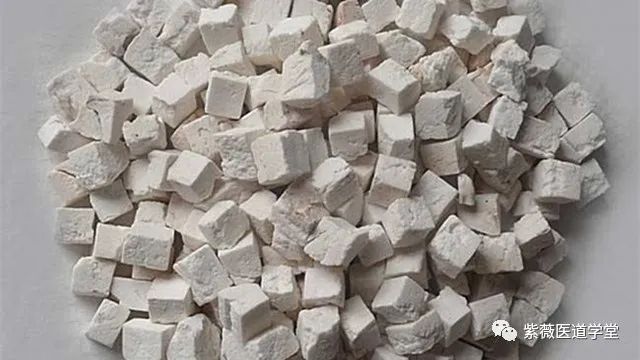
Note:Please follow medical advice for specific treatments and dosages!This article is excerpted from “Lin Zheng Ben Cao,” authored by Tao Yufeng, published by the People’s Health Publishing House, March 2005. This public account is used for academic exchange only; if there is any infringement, please contact for deletion, and please indicate the source when reprinting.

